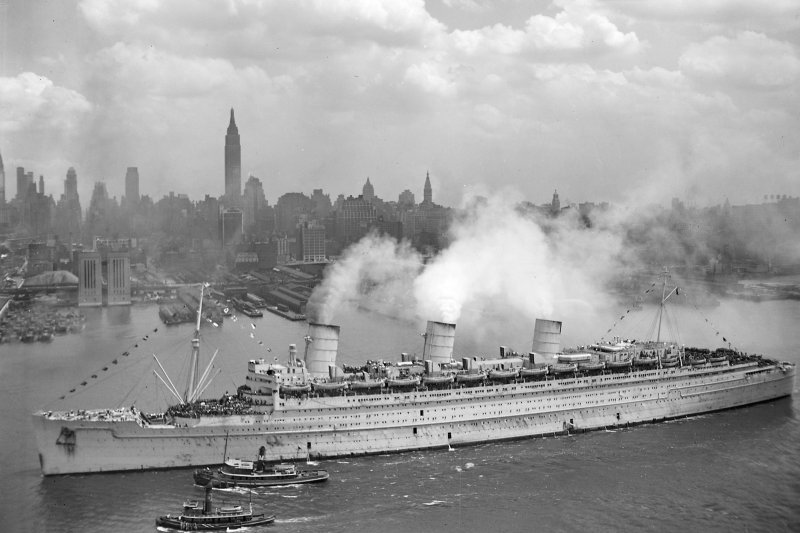The British liner RMS Queen Mary arrives in New York harbor on June 20, 1945, with thousands of U.S. troops from Europe. File Photo courtesy U.S. Navy
CLYDEBANK, SCOTLAND (United Press) -- The Queen Mary, mightiest liner afloat, was launched today with Queen Mary bestowing her own name as she christened it before 250,000 of her madly cheering subjects.
The costliest experiment in the history of maritime navigation was set afloat in the Clyde with a smoothness which was a tribute to the engineering skill of the builders.
It was sent on its way with a speech by King George in which he expressed the fervant hope that it would play an important part in revival of international commerce and promote friendship between nations, especially Great Britain and the United States.
He prayed that it might carry the people of the two lands to and fro to learn about and understand one another.
As soon as the king finished speaking, the queen pronounced the name of the new ship -- kept a close secret up to then -- and swung a weighted bottle of empire wine against the bow.
She pressed a button which released the supports, the workers leaped aside and the magnificent bulk of the liner slide slowly down the ways. The ways did not catch fire as expected.
The Queen Mary slid into the water, sending a great wave up and down the narrow river.
In a speech after the launching, Sir Percy Bates, chairman of the Cunard-White Star line, announced that construction of a sister ship would be started soon. The two will cost a total of about $90,000,000 and in conjunction will start a weekly express service both ways across the Atlantic, making the voyage in four days.
The liner, called the $40,000,000 gamble is 1,018 feet long, of 73,000 tons displacement, with 12 decks and is designed to recapture for Great Britain its old supremacy in the North Atlantic passenger trade.
It is both an answer and a challenge to the great strides made by France, Germany and Italy in the post-war years.
It is a gamble in that it may never make a penny for its owners; that like the American Leviathan it may serve as a symbol. Also, to be a commercial factor in passenger competition, it must be joined by a sister ship of equal cost and tonnage. Together the ships may cost $90,000,000, of which $47,500,000 will be lent by the taxpayer to the merged Cunard and White Star companies.
But it will be by 16,000 tons the greatest ship afloat. It will be equipped with everything that may insure its luxuriousness and its safety.
The 534, as it was called up to the moment that Queen Mary in christening it gave the signal for it to leave the ways of John Brown & Co., is to be completed early in 1936.
Its Diesel motored lifeboats, which may be lowered to the water in a few seconds under control of one man, will hold more persons, altogether than were carried by the first Cunard steamer Britannia on its voyage to the United States in 1840. Its fire alarm system is such that any sign of fire will be reported to the ship's bridge and permit the start of fire fighting work within a few seconds.
The new liner's 1,018 feet of length compare with the 915 feet five inches of the Cunard-White Star liner Majestic, and its 73,000 tons compare with the Majestic's 56,621.
The Leviathan is 907 feet six inches in length and of 48,943 tons.
It is planned to build a second ship in defense to the new "two ship" theory -- that money can be made in the highly competitive north Atlantic passenger trade only by using two ships, making fast trips and halting only briefly at their terminals. Previously three ships were used in such service. Germany has its Bremen and Europa, Italy its Rex and Conte de Savoia. France is building the Normandie, reported to rival the new British liner in size. What was to be the Normandie's sister ship, L'Atlantique, burned when nearing completion.
Work was begun on the new liner in 1930 and suspended a year later. It was resumed last April after the merger under British government auspices of the Cunard and White Star lines.
The ship's speed remains a mystery. With its proposed sister ship it is to provide weekly service between Southampton, Cherbourg and New York.
In an official announcement of its launching, there was a hint that already marine architects are contemplating bigger and faster ships. Said the announcement:
"The new ship and her contemplated sister ship represent the smallest and slowest which could fulfill the required conditions and accomplish regular weekly service."
But the new liner is sufficiently big to capture the imagination. It is 118 feet wide, 135 feet high from keep to the top of the forward one of its three funnels, 234 feet high from keel to masthead. In its first class restaurant and foyer, 207 feet long, could be placed the first Cunarder and the three ships which Columbus took across the Atlantic. There will be 2,000 portholes and windows; its space for play totals nearly two acres; its promenade deck is 750 feet long. Its turbines have 257,000 blades, each band fitted. Its four sets of engines total 2,200 feet in length. Its electrical energy would be sufficient for a town of 150,000 people. It will have 30,000 electric lamps. Some 250,000 people have found direct or indirect employment in connection with its building. It will have three classes -- first, tourist and third, and even its third class accommodations will provide luxuries undreamed of not many years ago.
The king and queen left Balmoral castle by train for the scene, and arrived a few minutes before 3 p.m. The vast throng burst into a frenzied roar of cheering as the band started the strains of "God Save the King."















